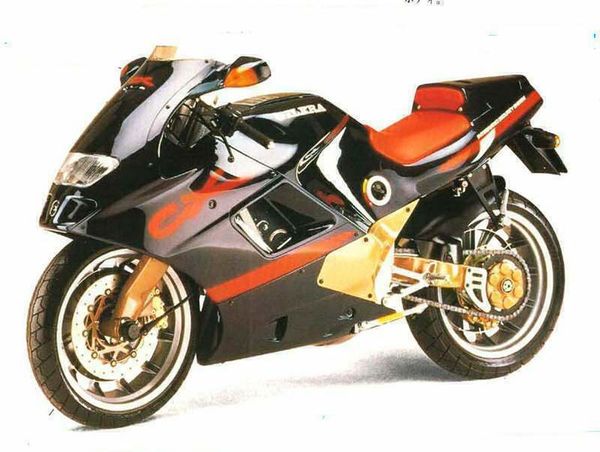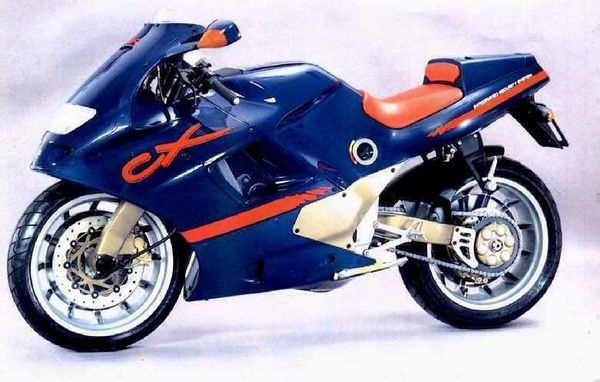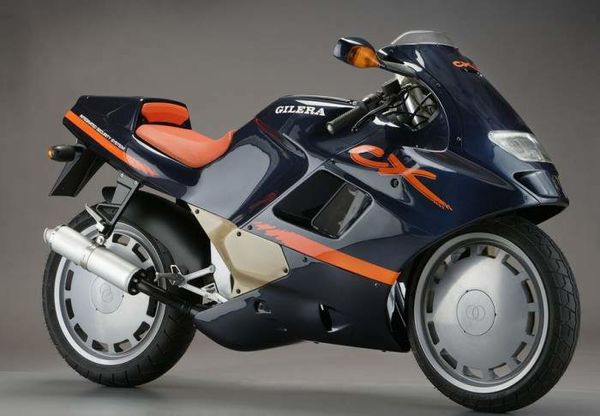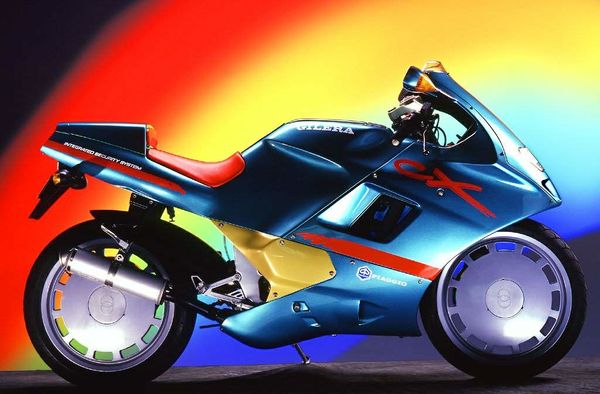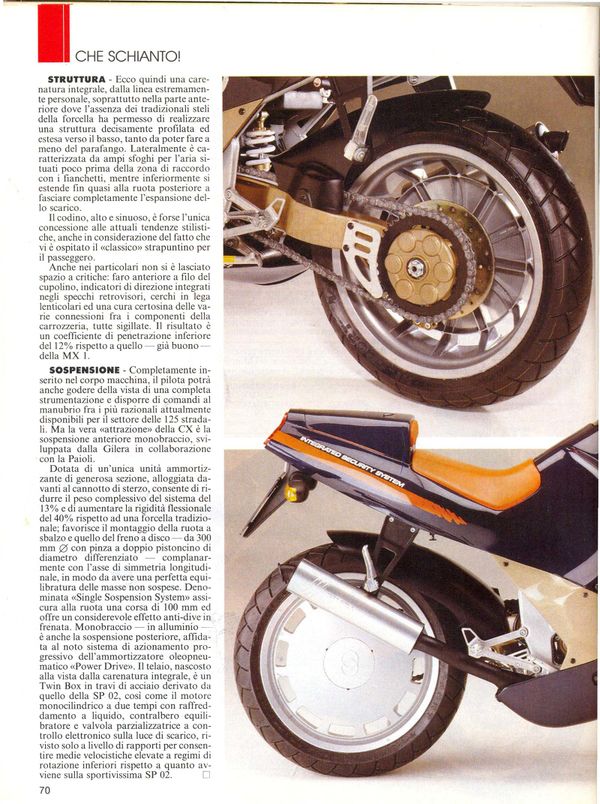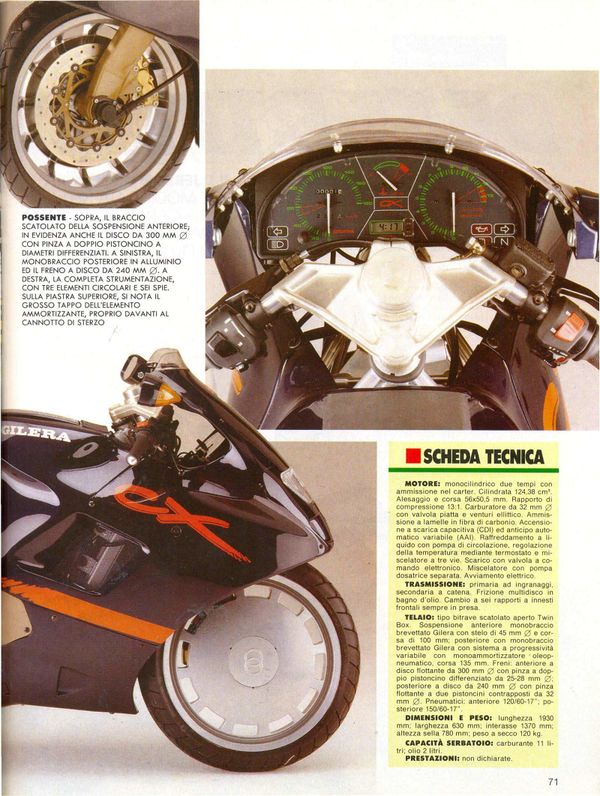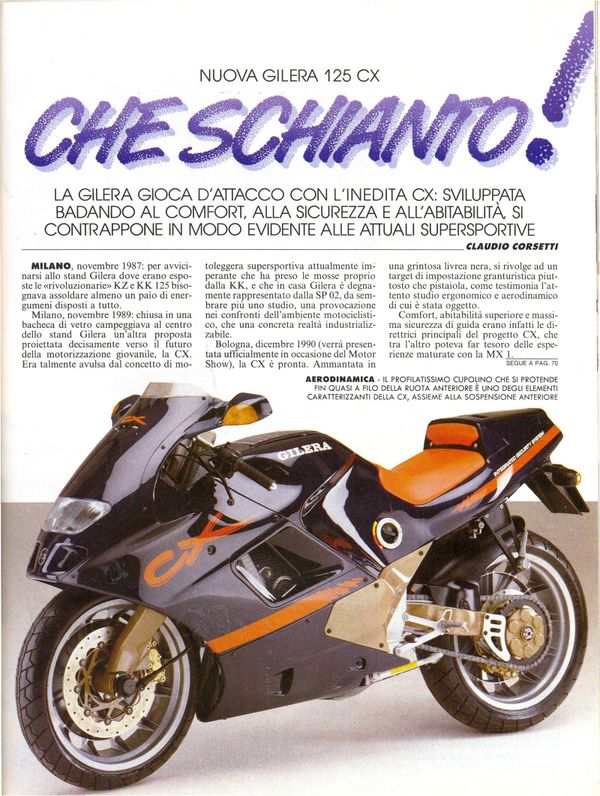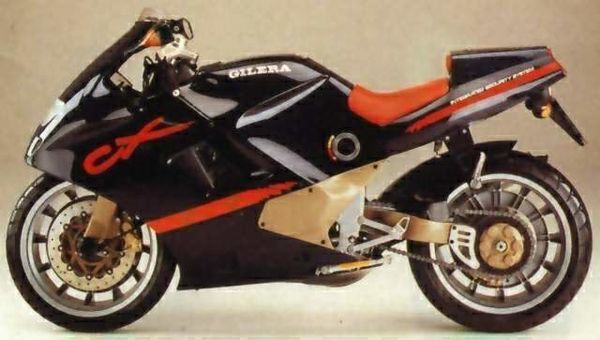Gilera CX125
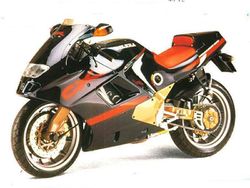 |
|
| Gilera CX125 | |
| Manufacturer | |
|---|---|
| Production | 1991 - |
| Engine | Two stroke, single cylinder, power valve |
| Compression ratio | 12.5:1 |
| Top Speed | 168.3 km/h / 104.5 mph |
| Horsepower | 28.97 HP (21.6 KW) @ 10900RPM |
| Torque | 13.28 ft/lbs (18.0 Nm) @ 10250RPM |
| Ignition | CDI |
| Transmission | 6 Speed |
| Suspension | Front: 45mm Paioli forks, 100 wheel travel Rear: Single swinging arm |
| Brakes | Front: Single 300mm disc Rear: Single 240mm disc |
| Front Tire | 120/60-17 |
| Rear Tire | 150/60-17 |
| Weight | 125.0 kg / 275 lbs (dry), |
| Fuel Capacity | 12 Liters / 3.17 US gal |
| Manuals | Service Manual |
The Gilera CX 125 was a liquid-cooled, two-stroke, single cylinder, power valve Sport Bike motorcycle produced by Gilera in 1992. Max torque was 13.28 ft/lbs (18.0 Nm) @ 10250 RPM. Claimed horsepower was 28.97 HP (21.6 KW) @ 10900 RPM. It could reach a top speed of 168.3 km/h / 104.5 mph.
Engine[edit | edit source]
The engine was a Liquid cooled cooled Two stroke, single cylinder, power valve. The engine featured a 12.5:1 compression ratio.
Chassis[edit | edit source]
It came with a 120/60 -17 front tire and a 150/60 -17 rear tire. Stopping was achieved via Single 300mm disc in the front and a Single 240mm disc in the rear. The front suspension was a 45mm Paioli forks, 100 wheel travel while the rear was equipped with a Single swinging arm. The CX125 was fitted with a 12 Liters / 3.17 US gal fuel tank. The bike weighed just 125.0 kg / 275 lbs.
Photos[edit | edit source]
Review[edit | edit source]
Gileras base is at Arcore, near the famous Monza racetrack on the outskirts of the city, and appropriately enough it was at the Milan Show that the local firm revealed their prototype CX - a futuristic machine looking every bit as weird as any catwalk creation - back in 1989. The CX was separated by a perspex screen from the prying public, most of whom must have assumed it was destined for production around the year 2000, if at all.
Late January 1991. The sun is finally sinking to end an unusually warm winter day, and Im still sneaking glances at the CX125 to assure myself that this surreal-looking motorcycle really is the bike Ive just been riding; a machine that will be rolling off the Gilera production line and into hundreds of showrooms by the time you read this . The idea still seems faintly ludicrous, like being able to buy a Versace ballgown in a department store. But the CX is indisputably real, and although you wont be able to buy it in Britain in the near future - supposed Gilera importers Suzuki GB are barely aware of the bikes existence, so dont hold your breath - then the masses in other countries across Europe certainly will.
The CX was designed by the Armani of the motorcycle world: Gileras chief engineer Federico Martini, whose previous creations include the Bimota DB1, perhaps the most beautifully styled bike of all time. Even the DB1 looks almost normal in comparison with the striking CX, whose uniquely strange appearance is capped by near-solid wheels which, from the right side, have no visible means of support.
This is haute couture in cold metal and plastic, and unlike a fancy frock the little CX has much more going for it than mere looks. The bikes dramatic appearance has been shaped by its suspension design, which uses single-sided arms and a single damper unit at each end. If the Bimota Tesi - which was first developed when Martini was design chief at Rimini - is this years most technically innovative motorcycle, then the CX is not far behind.
Nevertheless, if you strip
away the sculpted plastic and ignore the front suspension, the CX is improbably
conventional - if such a word can ever be used to describe the current crop of
state-of-the-art 125cc two-strokes. Its motor is this years version of Gileras
watercooled eighth- litre powerplant. Its identical to the unit used in this
years Crono race-replica ( follow-up to the SP02 tested last November ) except
for a revised exhaust pipe, which softens the power delivery slightly and
removes a couple of horses from the top-end.
That means an output of approximately 30bhp (the factory are a little coy about revealing precise figures): enough to propel the typical Italian teenager to a top speed of a shade over 100mph. Apart from the pipe, the major engine mod is the adoption of an electronically operated exhaust power valve in place of the previous mechanical system. The new unit sits behind a perspex cover on the right of the engine, operated by a solenoid bolted to the rear subframe.
The main frame is a twin-spar job almost identical to the Cronos, made from steel rather than the aluminum used by Gileras teeny-market 125cc rivals from Aprilia and Cagiva. The frame contributes a mere 22lb to the CXs 264lb dry weight, even so, and holds an single-sided alloy rear arm operating a vertical shock.
But the front suspension is the vital part of the CX125, for it is unlike anything seen before. A single alloy arm, of roughly similar dimensions to the rear swing-arm, leads up from the front axle before curving above the top of the mudguard. Attached to the arm is the suspension unit: a single upside-down telescopic leg whose female section (the fork slider) sits just in front of the steering head.
A series of articulated alloy rods connects the main arm to what is effectively the bottom yoke, to operate the steering. The 17-inch front wheel, like the similar-diameter rear, is a curved aluminum disc that from the right side looks solid apart from a series of slots near its rim. It holds a single 300mm steel brake disc, gripped by a twin- piston Grimeca caliper, and wears a low-profile Michelin Hi-Sport radial tire.
Needless to say, the whole thing looks the absolute, Crufts-award-winning, dogs gonads - and the benefits dont end with the strikingly clean styling that the single-arm system allows. Gileras brochure trumpets a long list of CX ( What a name to give a bike like this!) advantages over normal telescopic forks, including not only increased rigidity and less weight, but also such things as improved driving characteristics and the potential for enhanced aerodynamics.
Engineer Martini had been much more restrained at the prouduction bikes launch at the Bologna Show last December, calling the CX a marketing bike, born by commercial requests that worked in much the same way as normal forks. From a technical point of view the weight is more or less the same and the rigidity is more or less the same, so there is no great advantage or disadvantage, he had said.
Such comparisons are difficult because the single-arm design, which has been produced in collaboration with the Paioli suspension company, has yet to be refined to the same degree. Gilera engineer Luca Bacchi has been responsible for much of the development: When we began work two years ago the suspension unit was much thicker, with a 60mm diameter, and the cast arm was also much thicker than it is now, he said. But we made many calculations and fatigue tests and concluded that this was too conservative, so we reduced the diameter to 45mm. Of course, we will try to reduce it again in the future.
Bacchi claims the CX is very close to the Crono, which wears 40mm upside-down forks, in front-end weight and rigidity. Perhaps the CX is a few grams lower, and its stiffness against flex and also torsional stifness is a bit higher - its hard to measure because this depends on the position of the linkage system. If we wanted to save more weight we could design a special front wheel, or use magnesium instead of aluminum.
As well as the improved ease of wheel removal, Bacchi mentioned a further asset of the system. A conventional fork experiences twisting force when you steer the bike at the beginning of a corner. The front wheel behaves like a flywheel, and the gyroscopic force is great. On a normal fork this is transmitted through the tubes and causes deformation, but on our system these forces are taken by the linkages and are completely excluded from the suspension unit.
Careful design has ensured that the asymetrical CX front-end is evenly balanced, with the single disc sitting neatly on the centre-line. Fitting the twin discs required by a bigger bike would of course not be quite as easy. Bacchi quickly replied that: In this case you would make a twin disc operated by a single caliper, as has been used before on sports cars.
But he declined to say whether he already had such a set-up on the drawing board. Simply sitting astride the lightweight CX125 - the first machine off the production line, I was told - was enough to assure me that a single disc would be quite enough for the debut model. The diminutive bike looks as strange from the pilots seat as its pointed profile does from the roadside.
The long, flat nose section ends in a narrow perspex strip that you can look through if you crouch down behind the instrument panel (which includes a clock) with your chin resting on the enormous round suspension cap poking through the alloy top yoke.
In the absence of twin fork legs, the yoke is triangular only because it holds the narrow handlebars. Theres plenty of steering lock; so much so that the tire fouled the fairing slightly on full-turn. The footpegs are high and rearset, and the thinly-padded seat completes a singleminded riding position. A touch of the starter button produced a tinny two-stroke crackle just like that from any of the similarly-appointed race-rep 125s.
And on the road the CX felt pretty much like its conventional brethren; so much so that if I hadnt known its suspension was so unusual I probably wouldnt have suspected a thing. The engine is the predictable unrestricted 125cc buzz-bomb, though marginally less of an out-and-out racer than the likes of Cagivas Mito, which has seven gears and needs several more unless youre quick-footed.
The Gilera stables nearly all its 30 ponies at the top- end, redlining at 12,000rpm and needing most of those revs if youre to make the most of it. The power valve cuts in at just below eight grand, below which the acceleration is as feeble the exhaust note is flat. But when you reach the magic point on the tacho - which happens at 70mph if youre lazy enough to be dawdling in top gear - the little motor opens its lungs, the sound changes from a drone to a harsh shriek, and the CX picks up its skirt and heads for the horizon.
But handling is the CXs most important aspect, and the Gilera lived up to its engineers claims. The suspension is fairly stiff (theres 100mm of travel at the front, compared to the Cronos 130mm, for example) and the bike has a taut, racy, flickable feel due in part to its light weight and racy rake and trial figures. On the twisty country roads in the hills not far from Gileras factory it could be thrown around with great ease and precision.
And despite that light weight and radical geometry, the CX proved impeccably stable even on one fast, uneven fourth-gear curve that I repeatedly attacked as fast as I dared for Goldmans lens. The harder I rode, the more planted and secure the non-adjustable front felt; and the rear shock also behaved flawlessly even on the couple of occasions that the sticky, 150-section Hi-Sport gave a slight squirm to announce that it was close to the edge.
If there was a weakness, it was perhaps that the front felt a little solid when hitting bumps in a corner. But Im not at all convinced that the Crono or a similar small-bore sportster would have behaved any better. And there seems no reason why a more sophisticated suspension unit, ideally with facility for preload and damping adjustment, should not improve the CX ride still further. Such an impressive first attempt shows massive potential.
Which raises the vital question of where Gilera go next with their design, and whether it will appear soon with a decent-sized engine inside the slick plastic. Martini will confirm only that he is definitely planning more machines with single-arm suspension. Even if he obtains no performance advantage, he considers a little extra cost (the CX sells for 6.3m lire in Italy, against the Cronos 6.2m) worthwhile for the styling freedom it brings. But which engine to put in it? The factory are developing a big-bore V-twin, with a V4 roadster also possible in a couple of years time. And for the more immediate future, Gilera are rumoured to be working on a 680cc version of their twin-cam 560 single engine, and to have produced a prototype road version of their neat little alloy-framed single-cylinder racebike the Piuma.
Put the new engine in the Piuma frame, add CX-type suspension and style the result in the way that only Martini can, and youd have a 60bhp, 300lb streetbike that went like a rocket and looked like it had just arrived from Pluto. The most exciting thing is that if Gilera wanted to, they could build one next week. Its quite a prospect.
| Make Model | Gilera CX 125 |
|---|---|
| Year | 1991 - |
| Engine Type | Two stroke, single cylinder, power valve |
| Displacement | 124 cc / 7.6 cu-in |
| Bore X Stroke | 56 x 50..5 mm |
| Cooling System | Liquid cooled |
| Compression | 12.5:1 |
| Induction | 32mm Dell'Orto VHSA32AS |
| Ignition | CDI |
| Starting | Electric |
| Max Power | 29.3 hp / 21.8 kW @ 9900 rpm |
| Max Torque | 18 Nm / 13.2 lb-ft @ 10250 rpm |
| Transmission | 6 Speed |
| Final Drive | Chain |
| Front Suspension | 45mm Paioli forks, 100 wheel travel |
| Rear Suspension | Single swinging arm |
| Front Brakes | Single 300mm disc |
| Rear Brakes | Single 240mm disc |
| Front Tire | 120/60 -17 |
| Rear Tire | 150/60 -17 |
| Dry Weight | 125.0 kg / 275 lbs |
| Fuel Capacity | 12 Liters / 3.17 US gal |
| Consumption Average | 16.8 km/lit |
| Braking 60 - 0 / 100 - 0 | 13.0 m / 38.3 m |
| Standing ¼ Mile | 14.8 sec / 142.5 km/h |
| Top Speed | 168.3 km/h / 104.5 mph |
